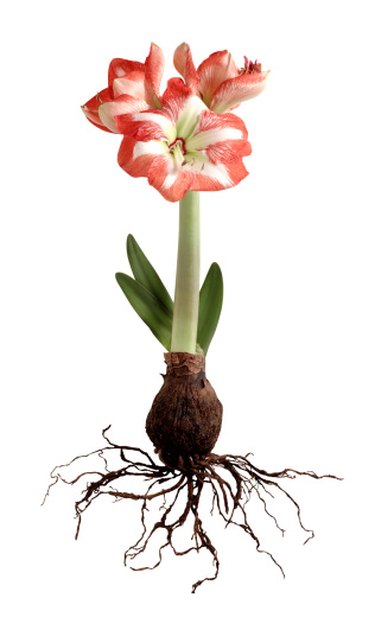
The amaryllis is a bulb plant, similar to tulips and daffodils. With large, colorful blossoms, amaryllis is often grown in winter and early spring, as it can be forced to bloom in greenhouses or indoors easily, despite the outdoor cold. The anatomy of the plant is a classic form, with roots, stem, leaves and a large flower that visibly displays the reproductive parts of the plant.
Roots
Video of the Day
The roots of amaryllis plants are relatively shallow and grow from a basal plate at the bottom of the bulb, projecting downward and outward in a cluster from the bottom of the bulb. They typically do not need a lot of soil. This allows amaryllis plants to be grown in small pots indoors.
Video of the Day
Bulb
The bulb is not a root. It is actually a modified portion of the stem, which is designed to store nutrients and protect the plant so that new growth starts each year. When temperatures warm up, the bulb will produce leaves and, eventually, sprouts called "scapes" which grow into long flowering stems. Amaryllis bulbs often produce small offshoots, or "daughter" plants that eventually grow into mature Amaryllis plants.
Leaves
The leaves of the amaryllis plant are somewhat fleshy, usually dark green, slender and strap-like in appearance. Amaryllis leaves may be relatively short, are often only a few inches long or may grow up to 2 feet in length. The leaves emanate from the bulb and frequently project upward and outward. The leaves of amaryllis typically die back in winter, although in the Deep South in the United States, they may remain evergreen.
Flower
The flowers of the amaryllis form at the top of a long stem grows from the center of the bulb. The plant may produce a single stem with blooms or multiple stems. Each stem may hold a single bloom or a cluster of two or three blooms which project outward. They are large and trumpet-shaped, each made of six radiating and overlapping petals. Colors range from white, yellow and orange, to reds, pinks and purples, sometimes with a variety of multicolored patterns. Petal shapes are sometimes frilly or curled.
Reproductive Organs
Each flower possesses both male and female reproductive organs, visible in the center of the bloom. The male organs are the stamens, which hold anthers that produce pollen -- the sperm of the plant. The pistil,is the female portion of the plant, which projects directly from the center of the flower, and consists of three parts -- the ovule, the style and the stigma. Pollen from the anthers, when transferred to the stigma, travels down the style and into the ovary to fertilize the seeds. Once fertilized, the flower dies, and the plant forms a large, bulbous pod filled with leathery, black seeds.